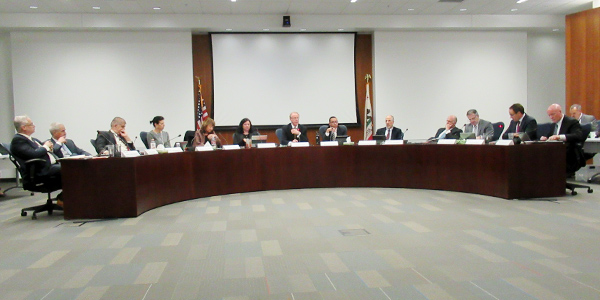By Hudson Sangree
FOLSOM, Calif. — CAISO’s Board of Governors unanimously approved a proposal Thursday meant to ensure that bidders from outside the ISO deliver electricity as promised or face more stringent financial penalties.
“The existing charge [for non-delivery] is relatively ineffective,” Brad Cooper, CAISO’s manager of market design policy, told the board in his presentation. That’s because participants rarely exceed a 10% monthly threshold when the charge kicks in. The new policy does away with that threshold.
Currently, “if intertie declines are less than 10% of total transactions, no charge applies,” the ISO wrote in an Aug. 15 issue paper. Anything more than a 10% failure-to-deliver rate can result in a charge of up to $10/MWh.
The lack of a financial incentive to follow through on bids can cause headaches, CAISO said in the paper.
“When an intertie resource receives a market award to import energy into the balancing authority area but does not deliver the awarded energy, the grid operator must maintain system balance by increasing internal supply or finding another intertie resource to import from,” it said.
Grid reliability and stable pricing depend on expectations being met, Cooper said at Thursday’s board meeting.
“When exports don’t deliver, they can cause intertie congestion,” he said. And “undelivered imports in a critical hour can have a big effect.”
The revised policy is also meant to curb speculative bidding — when a market participant submits a bid and doesn’t deliver because it can’t find the energy it promised or can’t find it at the right price.
When the 10% threshold was enacted in 2007, ISO computers couldn’t distinguish between an intertie “decline” and a reliability curtailment, officials said. That meant that reliability curtailments, which weren’t the fault of the market participant, could still count toward the decline charge.
The bar was set high at 10% to avoid penalizing participants who were unable to deliver because of unforeseeable problems.
Now the ISO’s system can distinguish between curtailments and non-deliveries, meaning the 10% threshold can be eliminated. Instead, non-delivery charges will be assessed in 15-minute intervals and “non-delivery will be subject to a charge equal to 50% of the maximum of the 15-min market or the five-minute real-time dispatch LMP, with a $10/MWh minimum, plus any imbalance energy,” according to the ISO.
Cooper said most stakeholders supported the plan as a way to reduce speculative bidding and to enhance reliability.
Severin Borenstein, a University of California Berkeley professor attending his first meeting as a newly appointed CAISO governor, asked planners to clarify why the charge applies to interties but not inside the ISO’s system.
Keith Casey, CAISO’s vice president for market and infrastructure development, explained that if an intertie bid — always scheduled an hour ahead of delivery — doesn’t materialize, the ISO can’t clear additional intertie energy until the next hour, but internally it can resort to the five-minute market to cover the shortfall.





